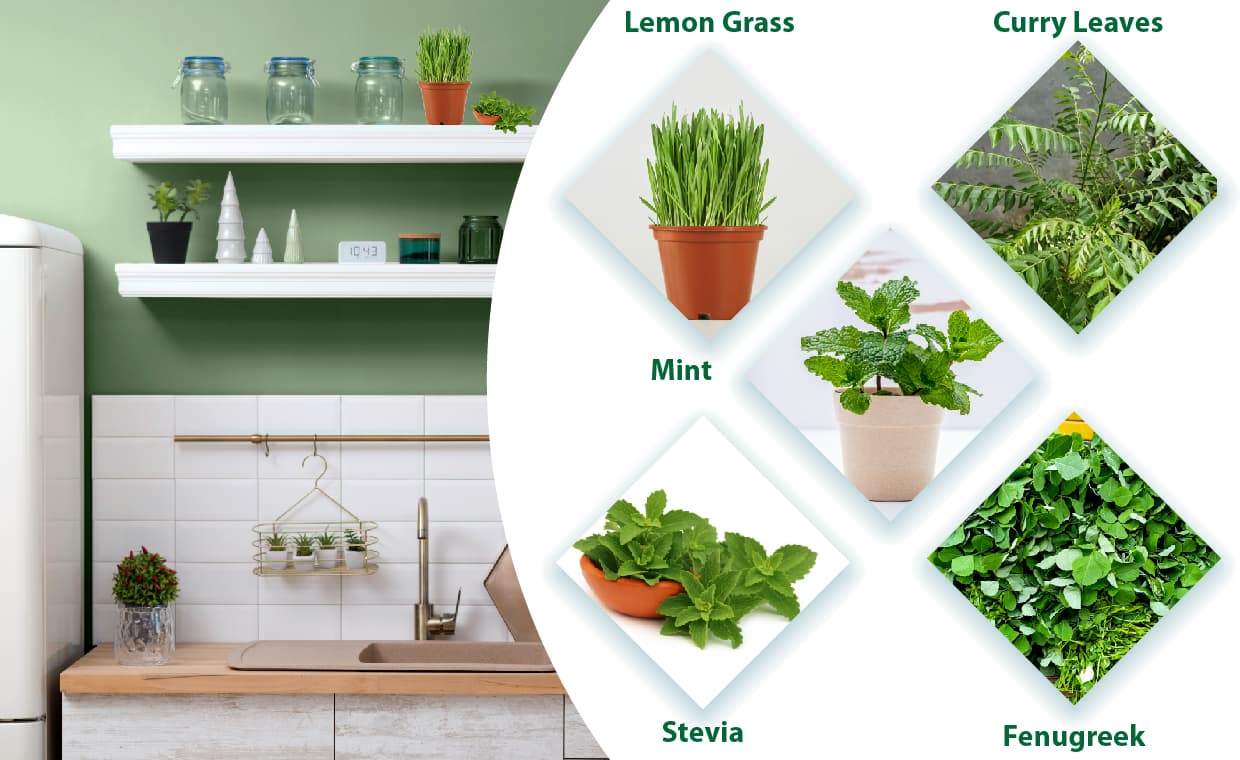
Are you fed up with the stale herbs from the market and want to experience the magic of fresh herbs in your dishes? Well, then the kitchen garden should be your next mission.
The kitchen garden is a small-scale vegetable and herb farm that you cultivate to source your fruits, veggies, and herbs.
Having a herb kitchen garden has many benefits. While herbs cleanse the air and repel mosquitoes and other insects, they also add to the aesthetics of the space. You are growing your herbs and you have the choice to stay away from harmful pesticides used otherwise. What more? You can convert the waste from your kitchen into precious compost and grow healthy and organic herbs to take your cooking experience to a new level while being a sustainability warrior.
In this article, Gharpedia brings to you a list of herbs to grow in your kitchen garden, and if space is a constraint, build a kitchen garden in your kitchen’s window boxes, on a patio, balcony, terrace, or other outdoor space nearby.
List of Herbs to Grow in Your Kitchen Garden
01. Cilantro or Coriander

Cilantro or coriander is an aromatic herb native to Asia and Southern Europe. It makes a delicious garnish for Mexican, Chinese, and Asian cuisines. This annual is a wonder plant that eliminates metal-based toxins from our bodies. As explained by Kathy Abascal and Eric Yarnell (Authors of the research paper – Cilantro – Culinary herb or miracle meditational plant?) coriander is used to treat anxiety and insomnia, burns, cough, digestive disorders, respiratory and urinary disorders, and dizziness.
02. Thyme

One of the best herbs for a kitchen garden is thyme. Thyme, a delicate-looking herb is integral to French and Italian cuisines.
With its lemony smell and earthy taste, it is a member of the mint family. Thyme serves as a flavouring ingredient and is high in vitamin A. It is anti-inflammatory, antibacterial, and antiseptic.
03. Mint

Mint with its citric aroma and fresh appearance jazzes up mojitos, cocktails, iced tea, desserts, etc. However, because it is an invasive plant, it is wise to grow mint in a separate pot. Mint calms the stomach and is good for breath freshening.
04. Oregano

Native to Europe, Asia, and the Mediterranean, Oregano or “Wild Marjoram” also belongs to the mint family. This perennial plant goes well in Italian and American recipes. It is effective in treating stomach issues, dandruff, muscle aches, joint pain, and fungal infections. So, include it in your kitchen herb garden.
05. Basil

An annual herb, basil, is another widely used herb in Italian and Mediterranean cooking. Basil doesn’t need watering every day, but you must remove the flowers regularly to prevent it from getting tart. According to Keith W. Singletary (Author of research paper – “Basil: A Brief Summary of Potential Health Benefits”), in Ayurvedic and other traditional medical systems, basil is used to treat gastrointestinal, kidney, respiratory, blood illnesses, skin, and eye conditions etc. Such herbs for kitchen gardens are a must.
6. Parsley

Parsley, a mildly bitter, nutrient-rich herb, enhances the flavour of stews. Give it abundant light and it grows bushy and big. While curly parsley is great for garnishing, flat parsley is better for cooking.
7. Lemon Grass

Tasting and smelling intensely like lemon, lemon grass is a must in your indoor kitchen garden. It is one of the best herbs for flavouring tea and seasoning various dishes. Lemon grass has a 6-foot average height. It offers beta carotene and other antioxidants, as well as protection against cancer and eye inflammation.
08. Chives

Chives are a member of the garlic family and are one of France’s “finest herbs.” It is mostly used for flavouring and goes well with sour cream. Chives are an Asian native. They have a flavour like onions. This perennial herb goes well with salads, soups, eggs, seafood, and potatoes and is rich in beta-carotene and vitamin C.
09. Rosemary

Rosemary is a very delicious herb with a lovely aroma.It has a beautiful scent and a needle-like appearance. It works well as a seasoning for foods including meat, poultry, and vegetables.
10. Fennel

One of the best kitchen herbs is fennel. This Mediterranean plant looks like dill. The bulbs are eatable, and the seeds are a key component of salad dressings, cheese spreads, bread dough, sausage mixes, and mouth fresheners.
11. Curry Leaves

Curry leaves are native to India, and the leaves of this kitchen herb are commonly used in South Indian cuisine. Curry leaves not only give curries and gravies flavour and fragrance, but they also promote healthy cholesterol levels and control diabetes.
12. Carom

Carom or its seeds, known as ‘ajwain’ in Hindi have therapeutic properties, particularly for treating stomach issues. It is a seasoning spice in many other cuisines, including layered flatbread and Indian flatbread.
13. Dill

Dill is one of the best kitchen herbs. It requires weekly watering and it aids digestion, fights bad breath, treats insomnia, menstruation issues, and eases cramping and swelling.
14. Mustard

The greens of mustard plant are edible, and the seeds (black, brown and yellow shades) are used for tempering and as spice. Mustard greens are the key ingredient in the iconic “Sarso da Saag” from Punjab.
15. Peppermint

Peppermint is a hybrid mint. It helps to lessen the effects of Irritable Bowel Syndrome, helps clear sinus congestion, and relieves headaches. Its natural oils promote digestion and ease menstrual cramps. Peppermint is widely used as flavouring agent in teas, mouth freshener, toothpastes, cough drops syrups and many other products and is well known for its antimicrobial and antioxidant properties. according to Parv Naik, AK Gupta, Tankesh Kumar and NU Joshi (Authors of research paper – “Peppermint a medicinal herb and treasure of health: A review)
16. Fenugreek

The dried leaves are normally added at the end as flavour enhancers. Methi seeds can be used to grow fenugreek, which can also be used as micro greens. Fenugreek seeds and leaves, both fresh and dried, are used in Indian cooking. This kitchen herb is truly versatile.
17. Tarragon

Despite being an Asian native, tarragon is perceived as a French herb. It has a subtle licorice flavour and being a perennial, you can replant it next year. This kitchen herb tastes great in meat dishes, soups, veggies, and sauces.
18. Sage

Sage is a perennial, flavourful herb that is frequently used in Mediterranean cuisine, especially in sauces and poultry dressings. Sage is great in stuffing and many other side dishes. It cures anxiety, inflammation after cuts, and prevents early ageing.
19. Bay leaves

Bay leaves from India is rich in flavour and aroma. The Mediterranean region is home to sweet bay. The dried variety of Indian bay leaves, also known as tej patta is used in curries.
20. Stevia

Stevia, a member of the sunflower family, also known as sweet leaf or sugar leaf, is a stunning plant that acts as a natural sweetener. Its great perk is that it has no calories, which makes it an efficient substitute for sugar.
Stevia is a freshly discovered sugar substitute that, in comparison to cane and beet sugar, is 20 to 30 times sweeter as claimed by S. D. Singh and G.P. Rao (Authors of research paper – Stevia: The herbal sugar of 21st century). With its antibacterial and anti-plaque qualities that help with digestion and weight loss, it is one of the best herbs for a kitchen garden.
Here’s a video to sum up all the points mentioned above & below:
Suggestions for a Thriving Indoor Herb Garden
Feed Lots of Sunlight To Your Indoor Kitchen Herb Garden

Herbs love the sun. Give them six to eight hours of direct sunlight, and they will flourish and burst with flavours. However, if that’s not possible, you can use timed lighting system.
Also read: Indoor Plants At Home – Six Spaces That You Can Utilize And How?
Let It Drain, Be Gentle

Allow the pots to dry partly between watering. Always water your herbs slowly, giving the plant time to absorb the water. Make sure the containers have drain holes.
Right Pots for Your Indoor Herb Garden

Choose the ideal container with a saucer. The size of the pot should suit the herbs, and the material should be according to the humidity level in your home. Also, make sure your herb pots have adequate drainage. If you are running short of space, you can have a vertical home garden.
Trimming Your Herbs

Herbs require little shaping and care. However, it’s essential to remove the blooms as soon as you see them to promote leafy growth.
Conclusion
We hope you are now aware of the importance of kitchen garden and have your list of herbs to grow in your kitchen. Make the best out of this information and enjoy gardening.
Also read
Step By Step Tutorial to Start Your Herb and Vegetable Garden






























